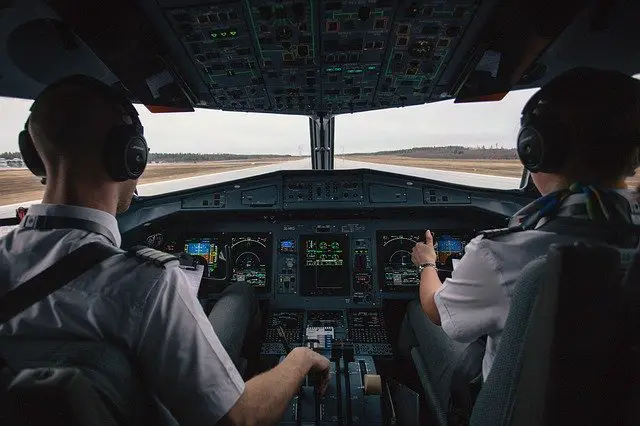A displaced threshold is a threshold on a runway at a position other than the beginning of the runway.
Table of Contents
What is a runway threshold?
Normally the runway threshold is located at the start of the runway. When a threshold is placed at position further down the runway this is known as a “displaced threshold”. The use of a displaced threshold reduces the available runway distance for landings
The Purpose of Displaced Thresholds on Runways.
A displaced threshold is usually used to increase the clearance between arriving aircraft and obstacles. By displacing the threshold further down the runway, it increase the height at which the aircraft will cross the airport boundary.
Terrain on the approach may be a factor which would require a displaced threshold to avoid GPWS (Ground Proximity Warning System) cautions or warnings.
Displaced thresholds can also be used for “noise abatement” over residential areas by increasing the height the aircraft would be at a point on the arrival, compared to landing on a threshold at the beginning of the runway.
What markings are used to show a runway threshold?
Runway threshold markings are are markings across the start of the runway that show the area suitable for landing. Threshold markings consist of white stripes centered on the runway centreline. The number of white bars/stripes depicts the width of the runway.
A threshold marking identifies the beginning of the runway that is available and suitable for landing. The runway threshold markings consist of eight white longitudinal stripes of uniform dimension arranged evenly about the runway centerline. These markings start 20 feet from the runway threshold.
FAA Airport Managers Handbook – Runway and Taxiway Markings
| Runway Width | Number of Stripes |
| 60 feet | 4 |
| 75 feet | 6 |
| 100 feet | 8 |
| 150 feet | 12 |
| 200 feet | 16 |
What are the markings for a displaced threshold?
If the runway displacement is permanent it is marked in two ways:
- White arrows in the centre of the runway pointing towards the displaced threshold
- A white “Runway Threshold Bar” at the displaced threshold extending the width of the runway.

Can you taxi or takeoff on displaced thresholds?
Displaced thresholds are load-bearing parts of the runway and therefore are available for taxi and take off. When landing from the opposite direction the displaced threshold is available for rollout.
Is a displaced threshold included in the runway length?
Displaced thresholds are included in the overall runway length but are not included as part of the Landing Distance Available (LDA).
- Take Off Run Available (TORA) – this is the physical length of the runway that is used for take off and includes the displaced threshold.
- Landing Distance Available (LDA) – this is “the length of the runway which is declared available…and is suitable for the ground run of an aeroplane landing”. (IR-OPS Annex 1 – Definitions)
The length of runway prior to a displaced threshold is not available to landing aircraft and therefore reduces the length available for landing.
Learn about factors affecting Take Off Performance here.
Example: John F. Kennedy International, New York
Let’s take JFK as an example. You have received the ATIS via datalink and you carry out your performance calculations for a landing on 22L.
During the approach ATC ask if you can accept 22R.
You take a look at your chart and see 22R at 3682m (12,080′) is much longer than your planned landing runway of 22L at 2560m (almost 8,400′). So you can take the switch to 22R? Wrong!

Although 22R looks to be much longer (and it is, for take-off ), because of its displaced threshold of 1044m (3,425′) its actually shorter than 22L. You might be able to land but you need to check your landing performance for the short runway.
Tip: in the cruise when you’re considering landing performance, consider the shortest runway you expect you might get. If you can land on the shortest one, you can land on any of them.
It’s rare to land on 22R in Kennedy as is normally in use for aircraft taking off.
Learn more about take-off performance here.
Frequently Asked Questions
What is Take Off Run Available (TORA)?
Take Off Run Available (TORA) is the length of runway available for the ground run of an aircraft taking off.
What is Take Off Distance Available (TODA)?
Take Off Distance Available is the length of the runway available for the ground run (i.e. TORA) plus clearway (if one is available).
What is a Clearway?
A Clearway (CWY) is an area, beyond the runway, that is clear of obstacles and in control of the airport authority. Clearway + TORA = TODA.
What is Landing Distance Available (LDA)?
Landing Distance Available (LDA) is the length of runway available for the ground run of landing aircraft.
Is a displaced threshold included in the runway length?
A Displaced Threshold reduces the Landing Distance Available (LDA) as the runway has in effect been shortened by moving the threshold further down the runway.
Can you land on a displaced threshold?
A Displaced Threshold is one that has been moved to a point further down the runway. You cannot land before this point, but if landing in the opposite direction the displaced threshold is available for rollout and taxi.
[Featured Image: Pascal Meier]
If you found this article interesting please take 5 seconds to share this on your favorite social media. Thanks so much, I really appreciate it! [email protected]

Pete has been flying aircraft for the last 20 years. He has flown everything from light piston aircraft up to heavy jets as both First Officer and Captain. He’s currently enjoying life flying the Airbus A330 for a major international airline.






